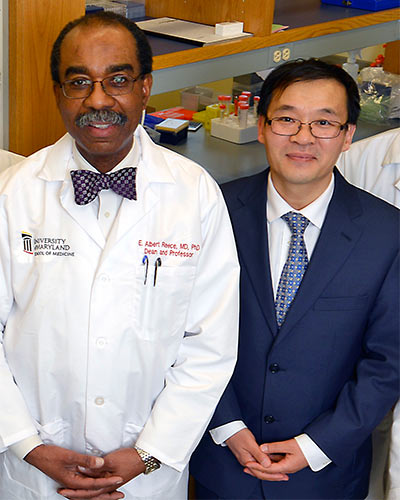May 12, 2017 | David Kohn
Scientists Also Identify Potential Medicine That Could Reduce Key Mechanism of These Diseases
A new study by researchers at the University of Maryland School of Medicine (UM SOM) has found a link between some neurodegenerative diseases and a birth defect that occurs commonly in infants of women with diabetes. This is the first time this link has been identified; it may indicate a new way to understand, and perhaps treat, both the birth defects and the neurodegenerative diseases.
The findings were published recently in the Proceedings of the National Academy of Sciences.

Zhiyong Zhao, PhD, E. Albert Reece, MD, PhD, MBA, and Lixue Cao, PhD
“These results were really surprising,” said the study’s lead author, Zhiyong Zhao, PhD, an Associate Professor of the Department of Obstetrics, Gynecology and Reproductive Sciences at UM SOM. “The association suggests that these disparate diseases may have more in common than we previously realized.” The researchers on the article also include UM SOM Dean E. Albert Reece, MD, PhD, MBA, and Lixue Cao, PhD, a Postdoctoral Fellow in the Department of Obstetrics, Gynecology and Reproductive Sciences at UM SOM.
Neural tube defects occur when misfolded proteins accumulate in the cells of the developing nervous system. The misfolded proteins form insoluble clumps, known as aggregates, which cause widespread cell death, eventually leading to birth defects. Protein aggregates also play a major role in Alzheimer’s, Parkinson’s and Huntington’s disease. In Alzheimer’s, for instance, this leads to the accumulation of plaques in the brain, reducing the ability of that organ to function.
The researchers studied pregnant mice with diabetes, and found that their embryos contained aggregates of at least three misfolded proteins that are also associated with the three neurodegenerative diseases: α-Synuclein, Parkin, and Huntingtin. It is not clear exactly how these protein aggregates contribute to those diseases, but the link is well established.
This latest research also underscores the links between diabetes and some neurodegenerative diseases. People with diabetes have a higher risk of Alzheimer’s and Parkinson’s disease, and some research suggests that there are molecular links between Huntington’s and diabetes as well.
The scientists also examined whether it is possible to reduce levels of the misfolded proteins, and in so doing reduce neural tube defects. They gave diabetic pregnant animals sodium 4-phenylbutyrate (PBA), a compound that can reduce mistakes in molecular structure by aiding the molecules that ensure proper protein folding. In the animals that received PBA, there was significantly less protein misfolding, and fewer neural tube defects in the embryos. PBA has already been approved by the US Food and Drug Administration for other uses, and if it proves safe and effective in humans for this purpose, it could potentially reach patients much more quickly than an entirely new drug.
Neural tube defects are birth defects of the brain and spinal cord. They occur in the first month of pregnancy. The two most common are spina bifida and anencephaly. In the first, the fetal spinal column doesn't close completely. This usually causes nerve damage, with some paralysis of the legs. In the latter, most of the brain and skull do not develop. Infants with this defect are usually stillborn or die soon after birth. Neural tube defects have several causes, including diabetes, folic acid deficiency, obesity in the mother, and consumption of certain medications. About 10 percent of women with diabetes who are pregnant will have embryos with neural tube defects.
“This research makes clear that there is often a direct connection between “basic” scientific research and clinical progress,” said Dean Reece, who is also the vice president for Medical Affairs, University of Maryland, and the John Z. and Akiko K. Bowers Distinguished Professor. “Our goal with this work is not only to better understand diabetes in neurodegenerative disease, but to find more effective ways to help patients who suffer from these complex and difficult illnesses.”
About the University of Maryland School of Medicine
Celebrating its 210th Anniversary, the University of Maryland School of Medicine was chartered in 1807 and is the first public medical school in the United States and continues today as an innovative leader in accelerating innovation and discovery in medicine. The School of Medicine is the founding school of the University of Maryland and is an integral part of the 11-campus University System of Maryland. Located on the University of Maryland’s Baltimore campus, the School of Medicine works closely with the University of Maryland Medical Center and Medical System to provide a research-intensive, academic and clinically based education. With 43 academic departments, centers and institutes and a faculty of more than 3,000 physicians and research scientists plus more than $400 million in extramural funding, the School is regarded as one of the leading biomedical research institutions in the U.S. with top-tier faculty and programs in cancer, brain science, surgery and transplantation, trauma and emergency medicine, vaccine development and human genomics, among other centers of excellence. The School is not only concerned with the health of the citizens of Maryland and the nation, but also has a global presence, with research and treatment facilities in more than 35 countries around the world. medschool.umaryland.edu/
Learn More
• Proceedings of the National Academy of Sciences
• Department of Obstetrics, Gynecology and Reproductive Sciences
Contact
Office of Public Affairs
655 West Baltimore Street
Bressler Research Building 14-002
Baltimore, Maryland 21201-1559
Contact Media Relations
(410) 706-5260
Related stories

Friday, May 12, 2017
University of Maryland School of Medicine Researchers Identify Gene That Controls Birth Defect Common in Diabetes
Researchers at the University of Maryland School of Medicine (UM SOM) have identified a gene that triggers a process leading to the formation of neural tube defects, a problem commonly found in infants of pregnant women with diabetes. This is the first time the gene has been shown to play this role; it opens up a new way to understand these defects, and may one day lead to new treatments that could prevent the problem or decrease its incidence.
